This Jerk Pernil is going to open your eyes and taste buds to a world of possibilities. Not only does this succulent roast taste like you’ve taken a trip to Boston, Jamaica, but it is also so straightforward you can make it for this weekend’s family dinner. I’ll walk you through the ins and outs of making the best jerk spice marinade and best practices on finding and roasting a juicy pernil.
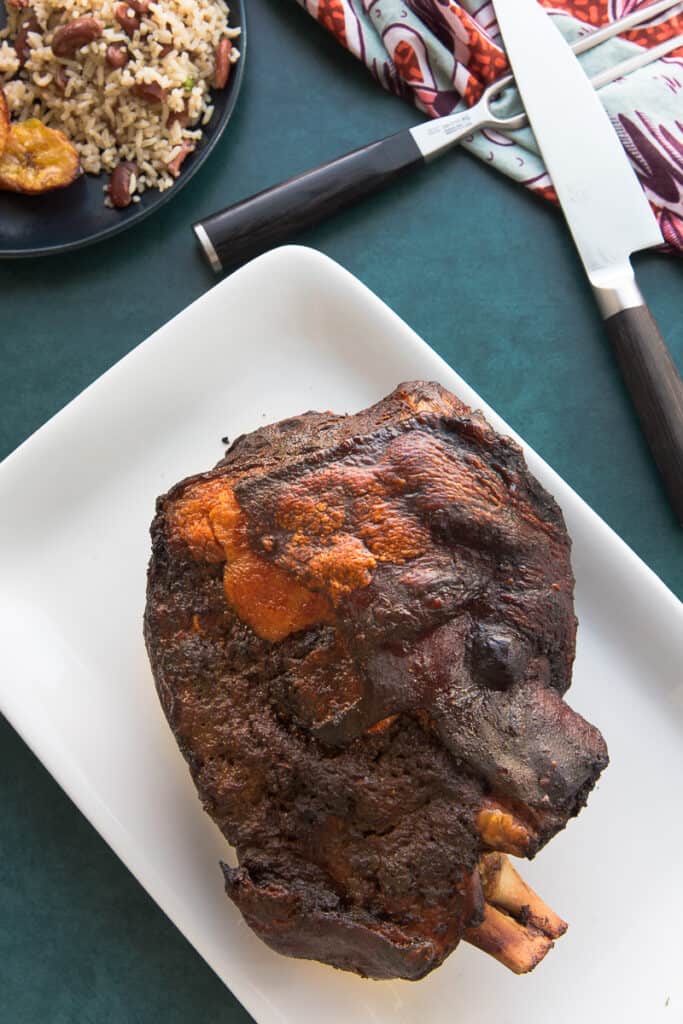
What is Jerk Pernil?
Jerk is a Jamaican invention, though many Caribbean islands prepare it. Pernil is a Puerto Rican creation, and the two have married here in this recipe.
Jerk pernil is a pork shoulder marinated with popular Jamaican flavors. If you’ve ever eaten jerk pork or jerk chicken, you have a general idea of the flavors headed your way. This version, however, is less smokey because we’re not cooking it over fire or wood. Pernil is the name given to a pork shoulder that’s slow-roasted in the oven. It’s a juicy piece of meat, which you’re bound to fall in love with.
Where does the word “jerk” come from?
There’s not much information on how the word “jerk” came to define this recipe. I mean, there’s a lot of speculation, but none of my research gave me solid facts. Having spent a period of my life as a Rastafarian, I hung out with many Jamaicans. Though I didn’t eat meat, I still learned that most of them taught me the name jerk came from how the meat was prepared. They pierced the meat with a jerking motion to allow the marinade (or spice rub) to better penetrate the meat. The other theory is that jerk refers to the person’s movements while cooking the meat. Their flipping the cooking meat looked jerky. A final theory was that the name came from the ancient Peruvian word meaning “jerky meat,” or meat cooked until chewy. That’s my least favorite theory because it’s not appetizing.
Is Jerk Pernil a Jamaican recipe?
Jerk pernil is a “me” thing. But jerk pork is a West Indian thing.
Jerk-style cooking comes from the West Indies, but specifically the island of Jamaica. Like the native Puerto Ricans, Jamaica had an indigenous tribe of inhabitants called Taínos. Taínos were among the finest barbequers, which is where we got the name. Barbacoa, where the word barbeque comes from, was the Taínos method of cooking meats over raised wood platforms. Later on, the freed enslaved people of Jamaica adopted many cooking methods from the island’s original inhabitants, including the hunting and barbequing of wild hogs.
That said, many other Afro-Caribbean islands have a version of jerk. The most popular and commonly known, though, is Jamaican.
What does Jerk pork taste like?
Jerk pork has a smokey, slightly spicy flavor. The smokey flavor of jerk pork is thanks to cooking over a pimento wood grill. Some jerkers steam their meat for a short time under damp stems of pimento leaves, as well. Pimento trees are where we get allspice berries, also used as a spice in the jerk marinade.
Because the meat is marinated for hours in a soy-based sauce, it also has tons of umami flavor. Though this jerk pernil is not cooked traditionally, it still has a delectable taste. If you want to prepare authentic jerk meat, be ready to set up a wood grill. But I’ll also give you some tips if you don’t have the space or faculty to do all of that.
What do I need to make Jerk marinade?
To make this version of jerk pernil, you need soy sauce, lime juice, white onion, green onions, scotch bonnet peppers, pepper, salt, Pumpkin Spice Blend, allspice, coriander, fresh thyme leaves, molasses, garlic, ginger, a 10-pound pork shoulder, and white vinegar.
Blending the jerk marinade in a blender is the easiest way to prepare it, so I recommend pulling one out. You also need a roasting pan, but preferably two. Those disposable aluminum pans are great for this.
Is Jerk seasoning spicy?
Jerk seasoning is slightly spicy because it’s made with scotch bonnet peppers. I don’t think it’s unbearably spicy, though. You can reduce the number of peppers you use in this recipe if you have a sensitivity to Scoville units, though.
On the contrary, if you’re a spicy food lover, go ahead and add another scotch bonnet. I would avoid adding more than 3 small scotch bonnets to this recipe, though. At some point, too much spice just becomes abusive to your taste buds and stomach.
Why is pumpkin spice used in this recipe?
The pumpkin spice blend is not a common ingredient in any Jamaican jerk recipe, but I have good reasons for including it. Most of the recipes I grew up eating and watching people make included cinnamon, nutmeg, cloves, allspice, and ginger. Well, the pumpkin spice blend contains every one of those same ingredients. Instead of listing and measuring out all of them individually, add them in one spoonful.
I believe the Jamaican gods smile on my efficiency.
What cut of pork do I need for this recipe?
Pernil comes from the front leg of the pig. Look for a label that reads “fresh picnic ham” or just “pork shoulder.” Avoid buying pork shoulders that have a solution injected into them. That solution is usually sodium nitrate or some other salty liquid pumped into the meat to give it flavor. We don’t need additional sodium or flavor because we’re adding our own with this marinade.
If you can’t find pork shoulder, buy a Boston butt instead. Boston butt comes from the same leg of the pig, just a little further up. It’s more tender than pernil because it’s used less, but it also doesn’t come with much skin. Both will work in this recipe.
Above all else, don’t buy a cured ham. Cured hams are already pumped full of so much solution that you’re going to end up with a salt lick.
Make holes in the meat of the pernil, but not in the skin. Keep the skin intact as much as possible. Poke holes on the sides and bottoms. Next, use the tip of your knife to cut between the meat and the fat cap under the skin. Make a pocket by cutting further and further into the meat. Check out this post if you need more details. Make more holes in the meat from the top once most of the skin is separated. Again, try to avoid puncturing the skin itself.
Put the meat into a large bowl or roasting pan and douse it with white vinegar. This “washes” or cleans the meat from slime or factory junk. It also starts to tenderize the meat. Be sure to pour it into the pocket you made as well. Allow the meat to sit in the vinegar while making the jerk marinade.
How can I make this gluten-free?
First, add the soy sauce to the blender. Some people are surprised to learn that Jamaica has a significant Chinese population. Soy sauce is among the many contributions Chinese-Jamaicans brought to the island. This ingredient gives the jerk color as well as an amazing umami flavor. Umami, or savoriness, is the fifth taste that many people find hard to describe. To me, it tastes sweet, savory, and salty all at once. Using soy sauce in the marinade is an easy way to add tons of flavor with minimal effort.
If you want to make this a gluten-free recipe, use tamari. The difference between soy sauce and tamari is soy sauce is fermented with wheat, and tamari is usually 100% soy, making it naturally gluten-free. Be sure to check the bottle’s label to make sure, though.
Add the lime juice, white onion, green onion, garlic, ginger, thyme, ground allspice, pumpkin spice, coriander, salt, pepper, molasses, and scotch bonnets to the blender with the soy sauce.
I can’t find scotch bonnets. What can I substitute it with?
Scotch bonnets aren’t always easy to find, so use habaneros instead if you can’t find them. Scotch bonnets aren’t as hot or bitter as habaneros, but the latter will get the job done in a pinch.
Can I omit the scotch bonnet if I don’t want it to be spicy?
You can omit the scotch bonnets if you don’t like spice at all. I will admit the flavor is a bit ho-hum without it, but it’s not bad in any sense of the word. You can, again, reduce the number of peppers to just one for a milder spice level.
Blend the ingredients on medium speed for 1 minute.
Why are my eyes burning??
You can thank the scotch bonnets for that. I have a friend, Andre, who’s the “KANG” (king) of jerk in our friend group. He has this whole mask, goggle, hat situation he dons to avoid blinding himself. The scotch bonnets have pretty potent oils that affect your eyes and respiratory system. Always be vigilant and wash your hands thoroughly when working with peppers. Use gloves if you have them. Above all else, don’t wipe your eyes or face before washing your hands if you’ve handled peppers.
The burning sensation wears off pretty quickly for me. You can wear one of your masks if you think it may irritate your respiratory system.
How far ahead can I make the Jerk marinade?
Stop the blender and scrape down the sides. Blend the marinade again, at medium speed, for another 30 minutes. This ensures the jerk marinade is completely smooth.
Keep the mixture in the blender for now.
This recipe is great because you can blend it and store it in a container in the fridge for a week. It makes enough jerk marinade for two of these pernil recipes if you’re using a 10-pound pernil. You can pour half of the marinade into a container and freeze it or, as I said, keep it in the fridge for up to a week.
Can I use this marinade on other proteins?
I like to use half to marinate this pernil and pour the other half over chicken thighs or wings. That way, I can make jerk chicken for dinner the same day and roast the pernil 3 days later.
This jerk marinade is great on chicken, seafood, or even tofu. The general measurement is: use 1/4 cup of jerk marinade per pound of meat. Chicken only needs a couple of hours to marinate, like, 4 hours. Seafood, only 20 minutes. Tofu, I would marinate for 30 minutes or so.
How long do I have to marinate the Jerk Pernil?
You can marinate the pernil in the jerk marinade for 1-3 days. I prefer to marinate it for a full 3 days because pork shoulder is a pretty large cut of meat. It takes time for the marinade to work its way through the meat. That said, I have roasted the pernil after only 1 day of marinating, and it was still tasty.
Pour 1 cup (250 milliliters) of the marinade into the bottom of a roasting pan. The bottom of the pernil will soak this up as it sits in the fridge. Pour another 1 1/2 cups of the marinade over the pernil and in that pocket you made between the fat and the meat. Rub the marinade into the meat a bit and try to push it into those holes you made earlier. Don’t forget to wash your hands really well when you’re done doing this.
Cover the dish with the pernil with plastic wrap and marinate the pernil for 3 days in the fridge.
Don’t marinate the jerk pernil for longer than 3 days, though. After 3 days, the meat isn’t sucking up anymore flavor, and you’re risking the meat going off. This is especially the case if you had your meat in the fridge a few days before marinating it. If you don’t think you can roast it 3 days after marinating, just wrap it really well in plastic and in a layer of foil and freeze it for up to 3 months. Thaw it in the fridge for 24-48 hours, and you can proceed with the recipe as instructed.
How long do I roast this Jerk Pernil?
After marinating the pernil for 3 days, remove the pernil from the fridge an hour before you start roasting it. This gives the meat time to warm up, so it’s not going into the oven ice-cold. Cold meat takes more time to roast to a safe internal temperature. Lower the middle oven rack to the next position down. You don’t want to put the pernil too close to the heating element, or it will roast unevenly. Preheat the oven to 350°F (177°C).
Rub off any excess marinade from the skin. This is likely to burn towards the end of roasting, so it’s best to remove it now.
The easiest way to describe my formula for roasting perniles is 30 minutes per pound at 350°F (177°C). For a 10-pound pernil, I roast it for 5 hours at 350°F (177°C). BUT! At hour 4, I crank the heat up to 425°F (218°C). That final hour of roasting is done at a higher temperature, and I’ll explain why that is later. Use this formula as the starting time for the meat.
Cover the pan lightly with foil. You don’t need to seal it too tight. I have found that when I do the skin splits (as you’ll see in the pictures). Try to leave a small vent hole for the steam to escape.
Slide the pan into the oven and roast it for 4 hours at 350°F (177°C).
Can I smoke Jerk Pernil?
To smoke this jerk pernil, marinate it and pull it out to warm up as instructed, then:
- Set up your smoker as you normally would for smoking large cuts of meat. If you have access to pimento wood, use that to smoke the meats. If not, apple or cherry wood are good substitutions. Heat the smoker to 250°F (121°C).
- Place the jerk pernil onto the grates of the smoker and smoke the shoulder for 4 1/2 hours, or when the internal temp reaches 150°F (65°C). You can use a spray bottle to spray Red Stripe beer over the jerk pork every hour for added flavor.
- After 4 hours, remove the jerk pernil from the smoker and wrap it in peach butcher paper. Return it to the smoker and continue to smoke the jerk pernil for another 4 1/2-5 hours. Remove the pork from the smoker when the internal temperature reaches 205°F (93°C).
- Place the jerk pernil, still wrapped, on a sheetpan in an oven that’s not turned on. Allow it to rest for 1 hour in the oven before unwrapping and serving.
Just a note: you’re less likely to achieve the crisp skin that most perniles have if you smoke it this way.
How do I make the skin on the Jerk Pernil crispy?
Remove the roasting pan from the oven after the jerk pernil has cooked for 4 hours. Increase the oven’s temp to 425°F (218°C). Carefully unwrap the pan. Sometimes the release of collagen from the skin causes the foil to stick to it. It’s okay if it does. Just be careful when removing the foil, so you don’t rip off too much.
If you have another disposable roasting pan, transfer the pernil to it. If you don’t, transfer the pernil to a platter and clean out the one you used to roast it up to this point. This sounds like a lot of drama, but when you return a pan filled with pork grease and jerk marinade to a super hot oven, they begin to smoke. That smoke not only fills up the kitchen but causes you to think that the pernil is burning. This is what leads to a lot of people pulling their perniles out of the oven too soon.
Place the pernil back into the roasting pan and into the 425°F(218°C) oven. Roast the jerk pernil for another hour. Turn the pan every 15 minutes to ensure the skin crisps up evenly all over. If the skin is still not crisp after 1 hour of roasting at this higher temperature, roast it for an additional 10-15 minutes.
How do you know when it’s fully cooked?
After the roasting time is done, remove the jerk pernil from the oven. The internal temperature of a shreddable jerk pernil should be 205°F (96°C). If you prefer a sliceable jerk pernil, you want the internal temperature to read 165°F (74°C). Adjust your roasting times to suit your preference. The meat will have a blush pink color (or darker) once you cut into it.
Allow the roast to cool for at least 30 minutes before cutting into it. Remove the cuero (skin) before pulling or slicing the jerk pernil.
What do I serve the Jerk Pernil with?
I serve this jerk pernil with my Arroz con Gandules and Platanos Maduros. You can serve it with many sides dishes or use it as a sandwich filling. Here are a few I recommend:
- Peruvian Style Coleslaw
- Five Cheese Baked Macaroni and Cheese
- Slow-Cooker Collard Greens with Smoked Turkey
- Puerto Rican Potato Salad
I’ll be updating the post soon to include more Jamaican sides to serve with this jerk pernil.
How do I store leftovers?
Shred or cut the meat from the bone after resting it. Transfer the meat to a container and store it in the fridge for up to a week.
Reheat leftovers in the microwave until warmed through. You can also heat leftover portions of jerk pernil in a covered skillet with a little (1/4 cup) of water.
Can I freeze leftover Jerk Pork?
You can totally freeze leftovers. To freeze leftover jerk pernil:
- Pull the meat from the bone and transfer it to a freezer-safe container.
- Freeze the meat for up to 3 months.
- Thaw it in the fridge overnight or reheat it from frozen.
This Jerk Pernil is a nice twist on a Puerto Rican favorite. I think you’ll agree once you taste it. Serve it at your next holiday or big Sunday dinner. Be sure to let me know what you think of it in the comments. Don’t forget to pin this recipe to your meats or dinner board as well.
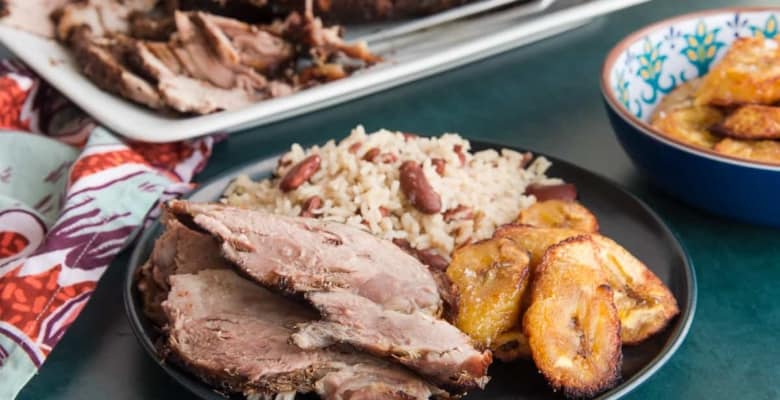
Jerk Pernil (Roast Pork Shoulder)
at Sense & EdibilityEquipment
- 2 roasting pans (disposable are best)
- blender
Ingredients
- 10 pound (about 4 1/2 kilograms) pork shoulder bone-in, skin-on
- 1/2 cup (120 milliliters) white vinegar
- 1 cup (250 milliliters) soy sauce
- 1/4 cup (60 milliliters) lime juice from 2 large limes
- 1 large (2 cups or 300 grams) white onion roughly chopped
- 6 (1 cup or 60 grams) green onions trimmed and roughly sliced
- 8 cloves garlic peeled and trimmed
- 3 inch piece ginger peeled and roughly chopped
- 2 scotch bonnet peppers stems removed and roughly chopped
- 2 1/2 tablespoons fresh thyme destemmed (or 1 1/2 tablespoons dried thyme leaves)
- 1 1/2 tablespoons (23 grams) kosher salt
- 2 teaspoons black pepper
- 1 1/2 teaspoons ground allspice (or 1 tablespoon allspice berries)
- 1 teaspoon Pumpkin Spice Blend
- 1 teaspoon ground coriander
- 1 1/2 tablespoons molasses (or dark brown sugar)
Instructions
Prep the Pernil for Marinating (Begin Up To 3 Days Ahead)
- Use the tip of a sharp knife to pierce deep holes in the bottom and sides of pernil, but not in the skin. Keep the skin intact as much as possible. Next, use your knife to cut between the meat and the fat cap under the skin, making a pocket between the two. Make more holes in the meat from the top once most of the skin is separated.
- Put the meat into a large bowl or roasting pan and pour the white vinegar over the entire pork shoulder and into the pocket you made as well. Allow the meat to sit in the vinegar while making the jerk marinade.
Prepare the Jerk Marinade
- To a large blender, add the soy sauce, lime juice, white onion, green onions, garlic, ginger, scotch bonnets, thyme, salt, pepper, ground allspice, pumpkin spice, coriander, and molasses. Blend the ingredients on medium speed for 1 minute.
- Stop the blender and scrape down the sides. Blend the marinade again, at medium speed, for another 30 minutes or until the jerk marinade is completely smooth. Keep the mixture in the blender for now.
Marinate the Pernil
- Pour 1 cup (250 milliliters) of the marinade into the bottom of a non-reactive roasting dish. Place the pernil into the marinade in the dish and pour another 1 1/2 cups of the marinade over the pernil and into the pocket you made between the fat and the meat.
- Rub the marinade into the meat a bit and try to push it into those holes you made earlier. Wash your hands once you're done doing this. Cover the dish with the pernil with plastic wrap and marinate the pernil for 1-3 days in the fridge.
Roast the Jerk Pernil
- Remove the pernil from the fridge an hour before you start roasting it to allow the meat time to warm up.Lower the middle oven rack to the next position down and preheat the oven to 350°F (177°C).
- Remove the plastic from the roasting dish and rub off any excess marinade from the skin. This is likely to burn towards the end of roasting, so it's best to remove it now. Lightly cover the roasting dish with aluminum foil, try to avoid pressing the foil onto the pernil.
- Put the pan into the oven and roast it for 4 hours at 350°F (177°C). Remove the roasting pan from the oven after the jerk pernil has cooked for 4 hours and increase the oven's temp to 425°F (218°C).
- Carefully uncover the pernil. Sometimes the release of collagen from the skin causes the foil to stick to it. It's okay if it does. Just be careful when removing the foil, so you don't rip off too much. Transfer the pernil to a clean, disposable pan if you have it. If you don't, transfer the pernil to a platter and clean out the pan you used to roast it up to this point.
- Place the pernil back into the roasting pan and into the 425°F(218°C) oven. Roast the jerk pernil for another hour, turning the pan every 15 minutes to ensure the skin crisps up evenly all over. If the skin is still not crisp after 1 hour of roasting at this higher temperature, roast it for an additional 10-15 minutes.
- After the roasting time is done, remove the jerk pernil from the oven. The internal temperature of a shreddable jerk pernil should be 205°F (96°C). If you prefer a sliceable jerk pernil, you want the internal temperature to read 165°F (74°C). Adjust your roasting times to suit your preference. The meat will have a blush pink color (or darker) once you cut into it. Allow the roast to cool for at least 30 minutes before cutting into it. Remove the cuero (skin) before pulling or slicing the jerk pernil.
Notes
Swaps and Substitutions:
- If you can't find pork shoulder, you can use Boston butt.
- Make a gluten-free jerk marinade by replacing the soy sauce with tamari.
- Use habaneros if you can't find scotch bonnet peppers.
- You can omit the scotch bonnets if you don't like spice at all.
- For a spicier jerk pernil, increase the amount of scotch bonnet peppers to 3.
- Replace the pumpkin spice blend with 1/2 teaspoon ground cinnamon, 1/4 teaspoon ground cloves, and 1/4 teaspoon ground nutmeg.
Tips and Techniques:
- Always be vigilant and wash your hands thoroughly when working with scotch bonnet peppers. Use gloves if you have them and don't wipe your eyes or face before washing your hands if you've handled peppers.
- This recipe makes enough jerk marinade for two of these pernil recipes. Store the remainder in a container in the fridge for a week or freeze it for up to 6 months.
- The jerk marinade is great on chicken, seafood, or even tofu. The general measurement is: use 1/4 cup of jerk marinade per pound of meat.
- Leave a small vent hole in the foil covering for the steam to escape to keep the skin from splitting.
- Using a clean pan to crisp the skin prevents the pork grease and jerk marinade from creating smoke.
Storage Instructions:
- Shred or cut the meat from the bone after resting it.
- Transfer the meat to a container and store it in the fridge for up to a week.
- Reheat leftovers in the microwave until warmed through. You can also heat leftover portions of jerk pernil in a covered skillet with a little (1/4 cup) of water.
Freezer Instructions:
- To Freeze Raw, Marinated Jerk Pernil:
- Wrap the marinated pernil in plastic and in a layer of foil.
- Freeze the pernil for up to 3 months.
- Thaw it in the fridge for 24-48 hours, and you can proceed with the recipe as instructed.
- To Freeze Leftover Jerk Pernil:
- Pull the meat from the bone and transfer it to a freezer-safe container.
- Freeze the meat for up to 3 months.
- Thaw it in the fridge overnight or reheat it from frozen.
Smoked Jerk Pernil:
- Set up your smoker as you normally would for smoking large cuts of meat. Smoke the meat with pimento wood if you can, if not, use apple or cherry wood. Heat the smoker to 250°F (121°C).
- Place the marinated jerk pernil onto the grates of the smoker and smoke the shoulder for 4 1/2 hours (the internal temp reaches 150°F (65°C)).
- After 4 hours, remove the jerk pernil from the smoker and wrap it in peach butcher paper. Return it to the smoker and continue to smoke the jerk pernil for another 4 1/2-5 hours.
- Remove the pork from the smoker when the internal temperature reaches 205°F (93°C).
- Place the jerk pernil, still wrapped, on a sheetpan in an oven that's not turned on. Allow it to rest for 1 hour in the oven before unwrapping and serving.

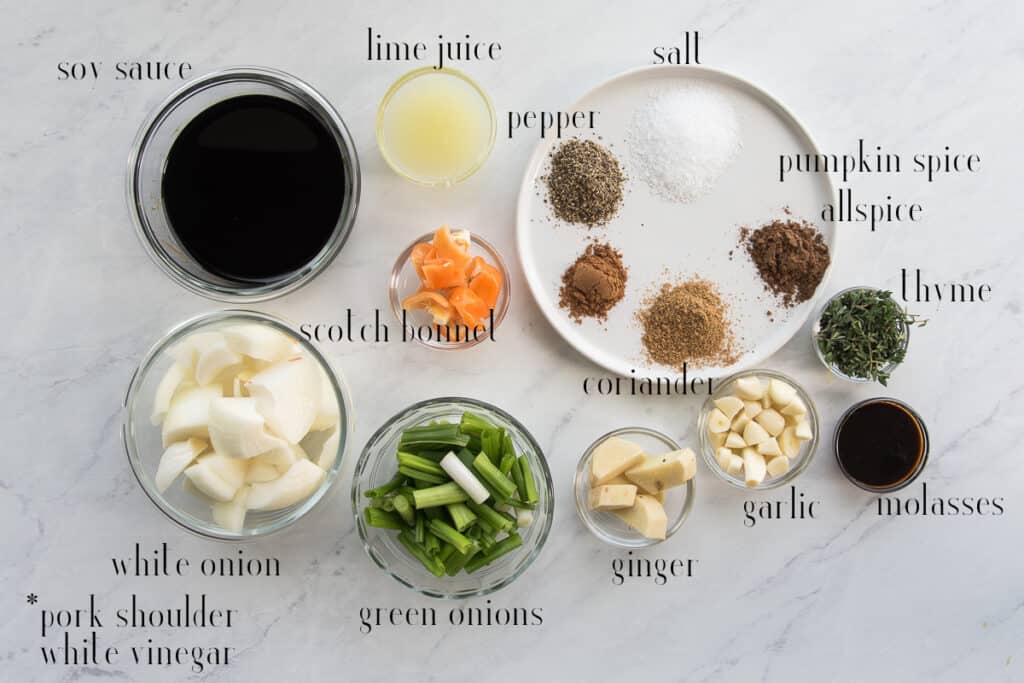
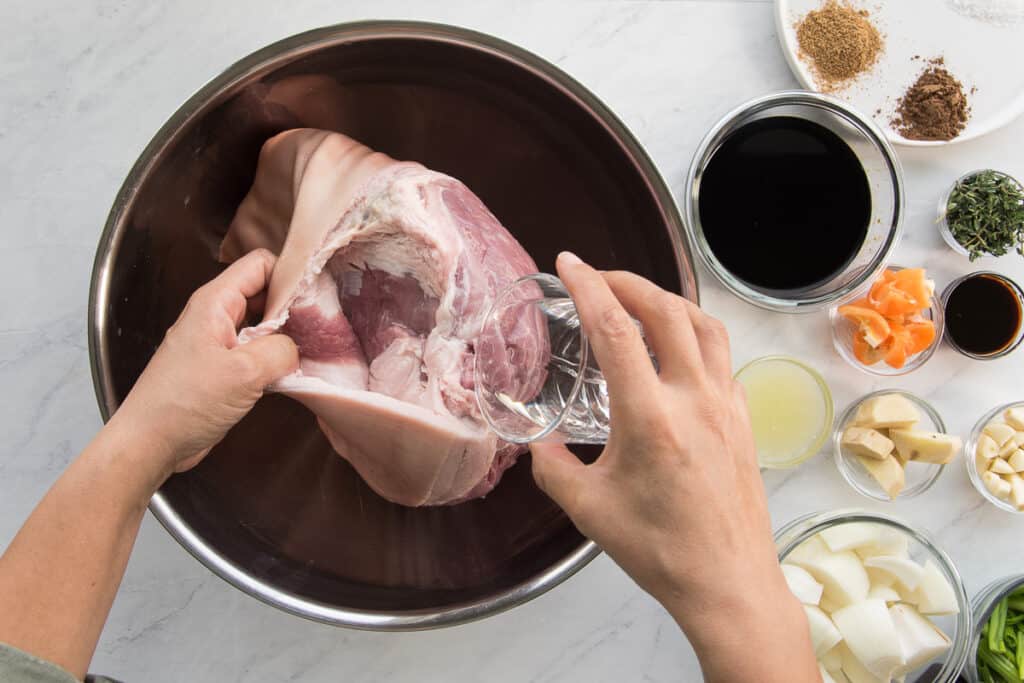
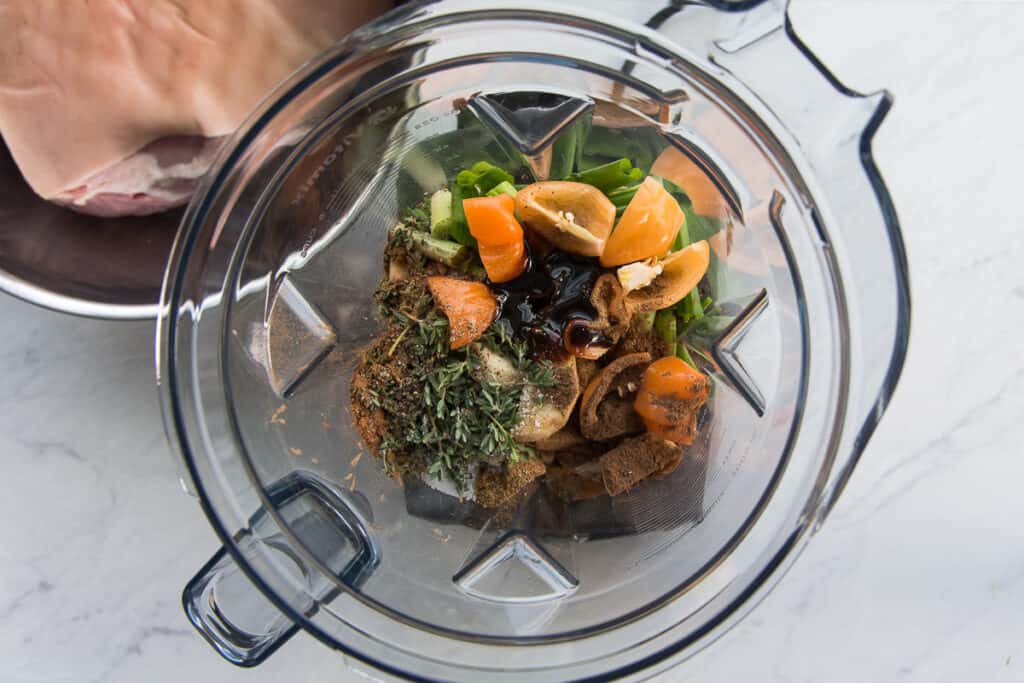
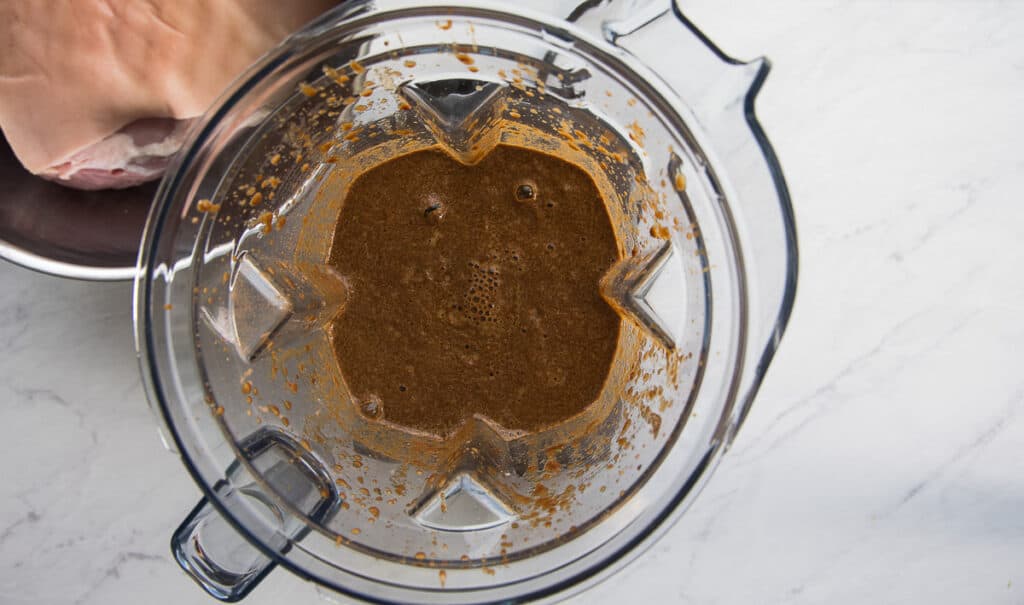
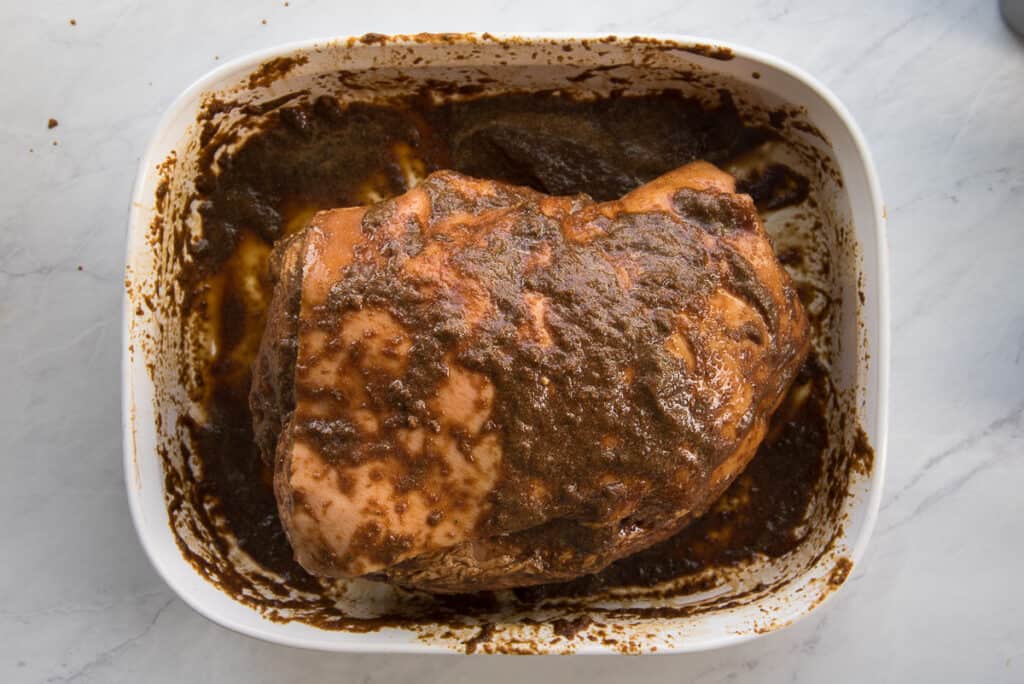
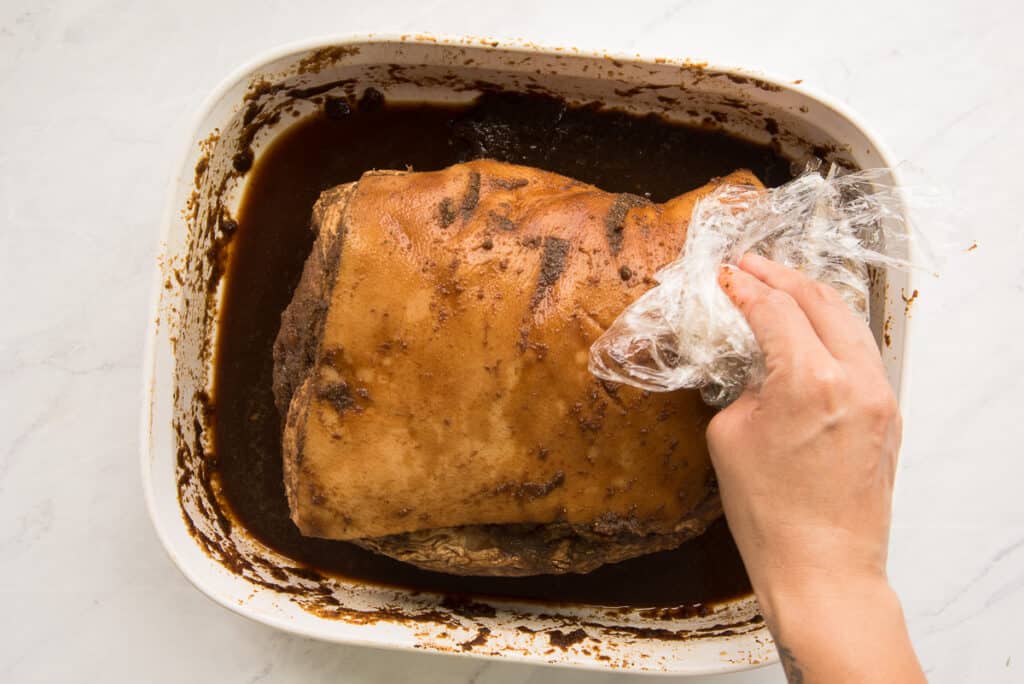
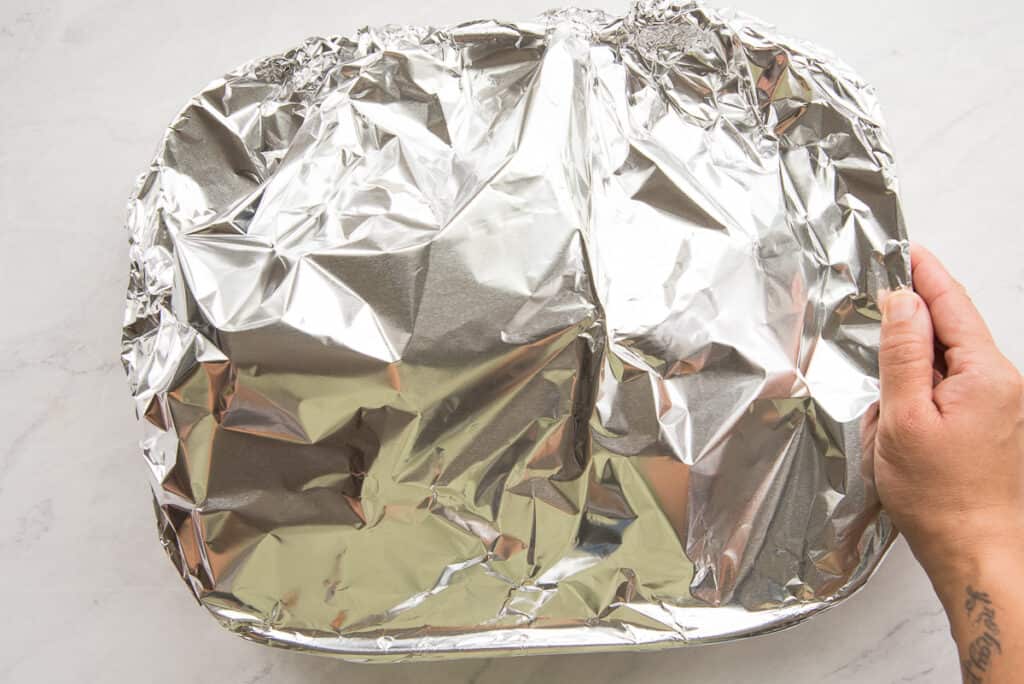
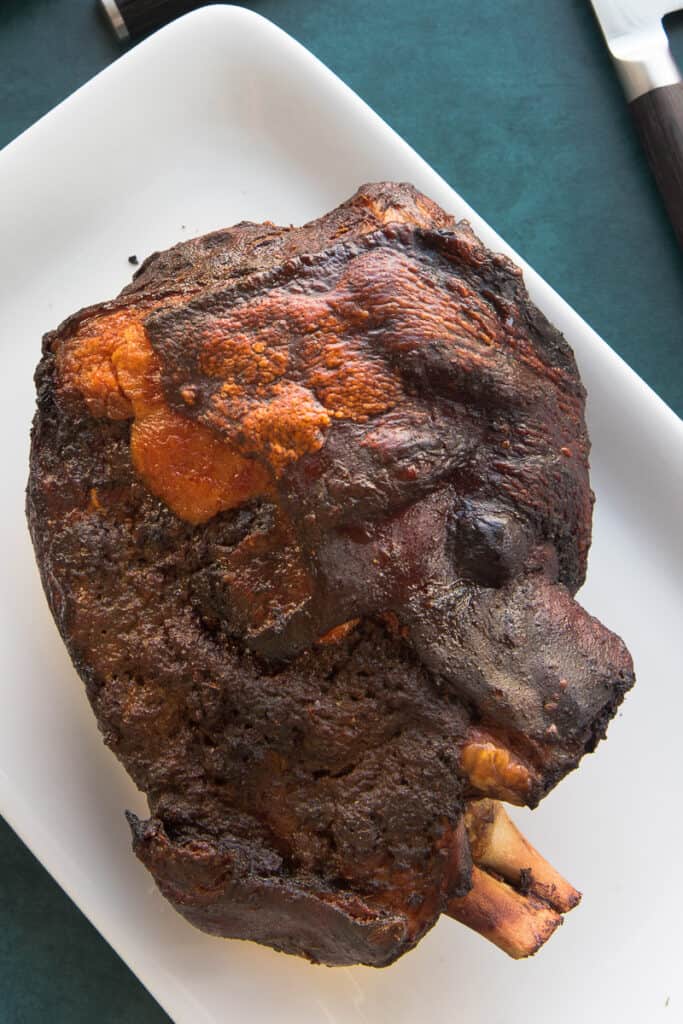
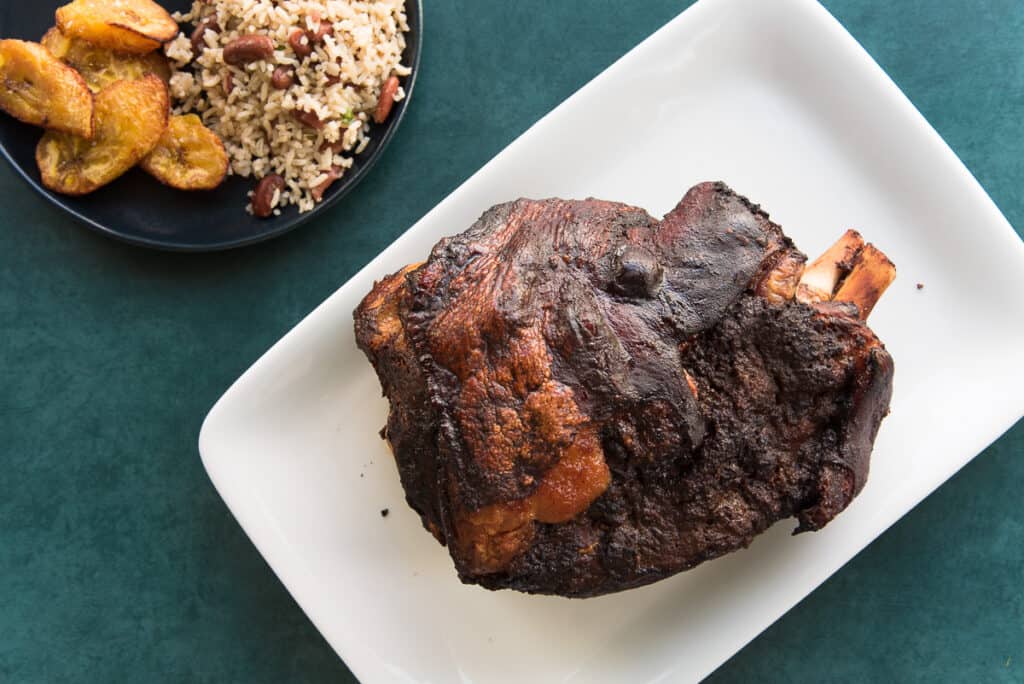
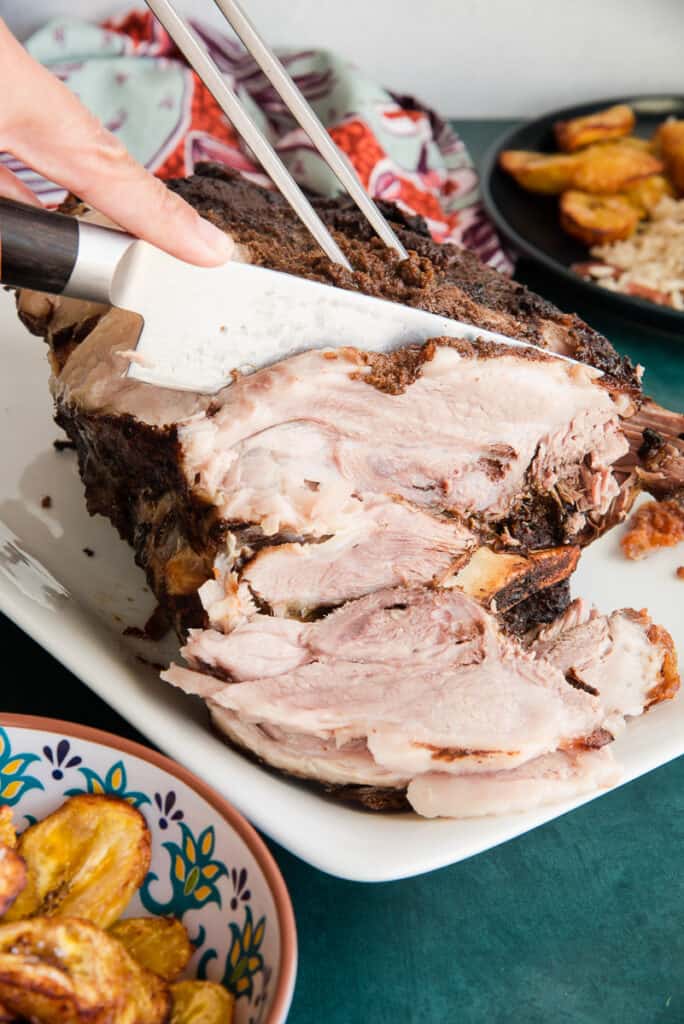
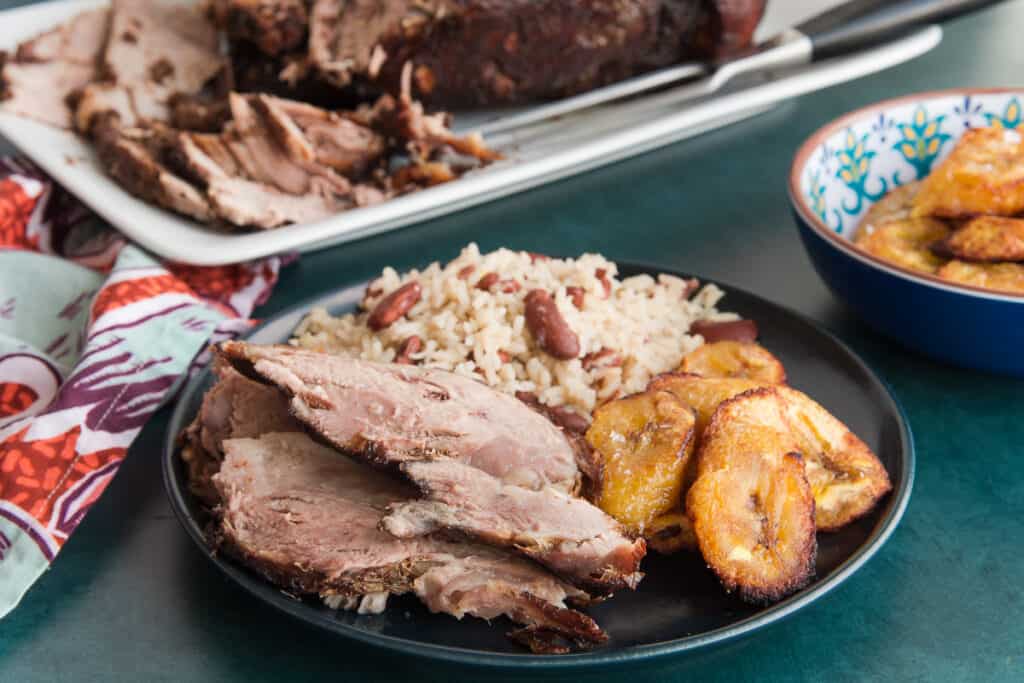
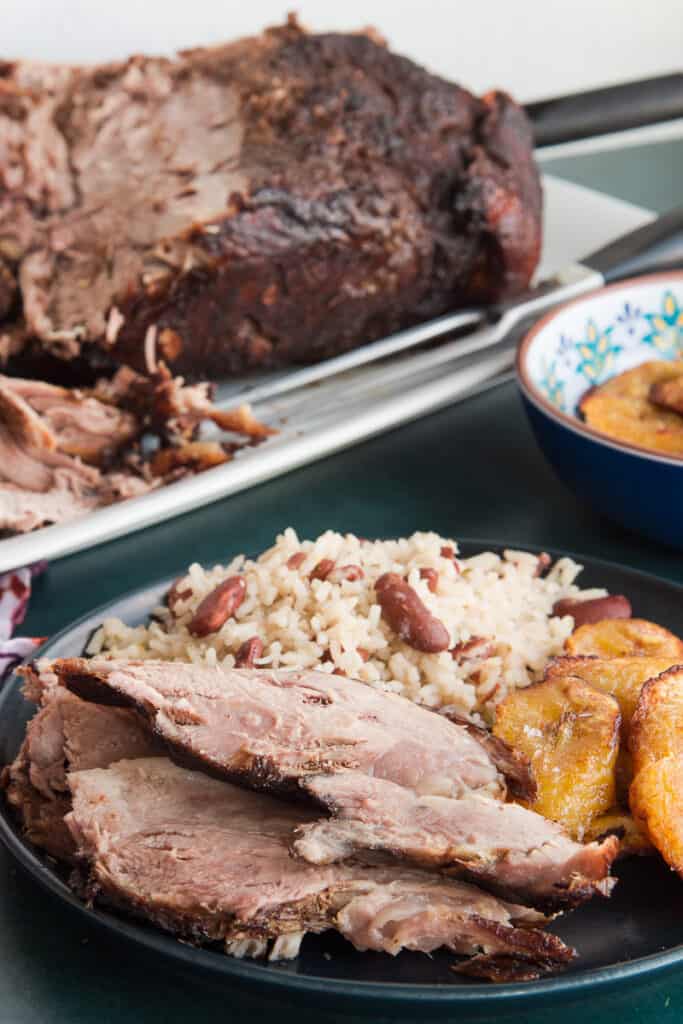


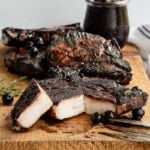


Marta what a delicious dish, a great combination of the Puerto Rican pernil with Jamaican flavors. We love jerk seasoning in our house, it’s so deep and delicious hard to resist really. You had me drooling over the pernil with maduros, what a great holiday dish.
I’m so glad you liked it, Silvia!
I had no idea the “jerk” part of the name came from the way the meat is handled! I’m not too familiar with Jamaican cuisine either but this was super delicious!
There’s so many different rationales behind the name, but that was the most common one amongst my friend group. I’m so glad you enjoyed it!
The combination of flavors was spot on and the pork was perfectly juicy and tender. I have a feeling I will be making this time and time again. Thanks for introducing me to another amazing dish!
I’m so happy to hear you enjoyed it Jessica!